Discover Kusu Island and St. John Island in Singapore

Kusu Island and St. John Island Fast Facts
- Kusu Island is one of the Southern Islands in Singapore, located south of the main island of Singapore (about 5.6 kilometres of distance between)
- St. John Island was once known as Pulau Sakijang Bender
- St. John Island is also located in Singapore’s southern area
- In Chinese, Kusu means “Tortoise” or “Turtle Island”
- In Malay, Kusu is known as Pulau Tembakul (Peak Island)
Kusu Island has two lagoons, barbeque pits, and nice beaches. Kusu is surrounded by reefs that include a large variety of hard and soft corals. Marine life in the area includes clown fish, anemone shrimps, and many other fishes and crabs that are rarely seen. Visitors to Kusu Island can go on a guided reef-walk with the Blue Water Volunteers. These guides are professionally trained and experienced in leading visitors safely through the best tides for a great view of the reefs.
What is the Kusu Legend
There are many wonderful legends of Kusu island. The story of how Kusu’s creation was envisioned entails two men and a turtle. Perhaps they were shipwrecked sailors, or just fishermen that were lost in the body of water around the island of Singapore. Either way, a giant turtle found them struggling beneath a powerful storm and transformed itself into a beautiful island to save them. In gratitude, they each honored the turtle and the island in their own way. One man was Chinese and he built a temple. The other was Malay and he built a shrine.
But perhaps the most significant part of the story is that they built a sculpture of the turtle together. Another point to add is that some people say that Kusu really did look like a turtle before it was reclaimed, because of two ridges on a reef: one ridge for the head, and the other for the back of the turtle. Now there are three Malay shrines on Kusu Island, along with the one Chinese temple, and the Tortoise Sanctuary.
Do people continue to honor the turtle
People continue the tradition of returning to the island and giving thanks to this day, but it is for the Kusu Festival which takes place during the Ninth Lunar Month of each year. Devotees visit by the thousands and they go to the Da Bo Gong temple to pray. They pay their respects not to the turtle, but rather to several deities (especially Da Bo Gong and Guan Yin).
Da Bo Gong is the Merchant God or God of Prosperity. The temple was built in 1923 by a wealthy businessman and not one of those two rescued men. Taoists visit each year during their pilgrimage to Tau Pekong Temple and Muslims go to the Kramat Kusu. There are 152 steps to the top and many people climb up to pray for harmony, marriage, wealth, and health, or in the case of childless couples, children.
Visitors can also take a trip to St. John’s Island
Visitors cannot stay overnight at Kusu Island and that is why they might be interested in heading over to St. John Island. St. John Island has a great Marine Aquaculture Centre and it has many opportunities for sports activities and beach trekking fun. There are swimming lagoons and soccer fields. People can rest at the Holiday Bungalow, which has a kitchen, and then go on a picnic. There are also Holiday Camps, but they do not offer much privacy. In either case, the locals enjoy visiting as well so tourists should make preparations before hand. For some night-time fun, Focus Singapore has waterfront bars and restaurants serving international foods along with local dishes.
Tips for Travelers
- These are great places to visit, but be respectful. Kusu Island used to be the burial grounds of immigrants who died in quarantine on St. John’s and Lazarus Islands.
- There is a daily ferry from Marina South Pier that is provided by the Singapore Island Cruise.
- Don’t forget to visit the Kusu Island wishing well for some good luck on your trip!
- Again, remember that camping overnight is not permitted on Kusu Island. Visitors can stay overnight at St. John Island’s Holiday Bungalow or Holiday Camp.
- Take some very good walking shoes, especially if you’ll be visiting both islands!